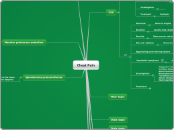Chest Pain
CVS
Angina
Character
Crushing, heaviness, discomfort or choking sensation.
Duration
usually short (typical duration 2 – 10 min).
Severity
Graded by New York Heart Association Classification (NYHAC) according to activity to the following:Class I : angina or dyspnea during unusually intense activity.Class II : angina or dyspnea during ordinary activity.Class III : angina or dyspnea during less than ordinary activity.Class IV : angina or dyspnea at rest
Site and radiation
Retrosternal area or the throat, central and may radiate to the jaw or the arms, rarely travel below umbilicus.
Aggravating and relieving factors
Aggravating factors:Stress ( as exercise, emotional excitement and cold weather).Relieving factors: A) Rest. B) Sublingual nitrate relief the pain within minutes.
Associated symptoms
Investigation
Treatment
Subtopic
MI
Character
Same of angina
Duration
usually long (typical duration 30 min or more).
Severity
More severe and occur at rest.
Site and radiation
Same of angina.
Aggravating and relieving factors
Often no obvious precipitant (not necessarily precipitated by exertion).- Not relieved by rest or nitrates.
Associated symptoms
dyspnea, sweating, anxiety, nausea, and faintness.
Investigation
Troponin T and troponin ICreatine kinaseRenal function and electrolytesBlood glucoseFull blood countSerum cholesterolElectrocardiography
Treatment
Main topic
Main topic
Main topic
Pleuritic chest pain
• Definition: chest pain made worse by inspiration.
• Cause: movement of the inflamed pleural or pericardial surfaces on one another.
• Occur in:
1- Pleurisy . 2- Pericarditis.
• Aggravating and relieving factors:
- Not brought on by exertion but relieved by:
1- Sitting up.
2- Leaning forward.
Subtopic
Chest wall pain
• Localised to small area.
• Sharp associated with respiration or movement of shoulders rather than exertion.
• Last for few seconds or to long periods.
Disease of cervical
or upper thoracic spine
Oesophageal spasm
• Retrosternal.
• Come after eating or drinking.
• Associated with Dysphagia.
• Relieved by nitrate.
Pain due to dissecting
aneurysm of aorta
Massive pulmonary embolism
Spontaneous pneumothorax
• Sharp pain.
• Localized to one part of the chest.
• Associated with severe dyspnea.
